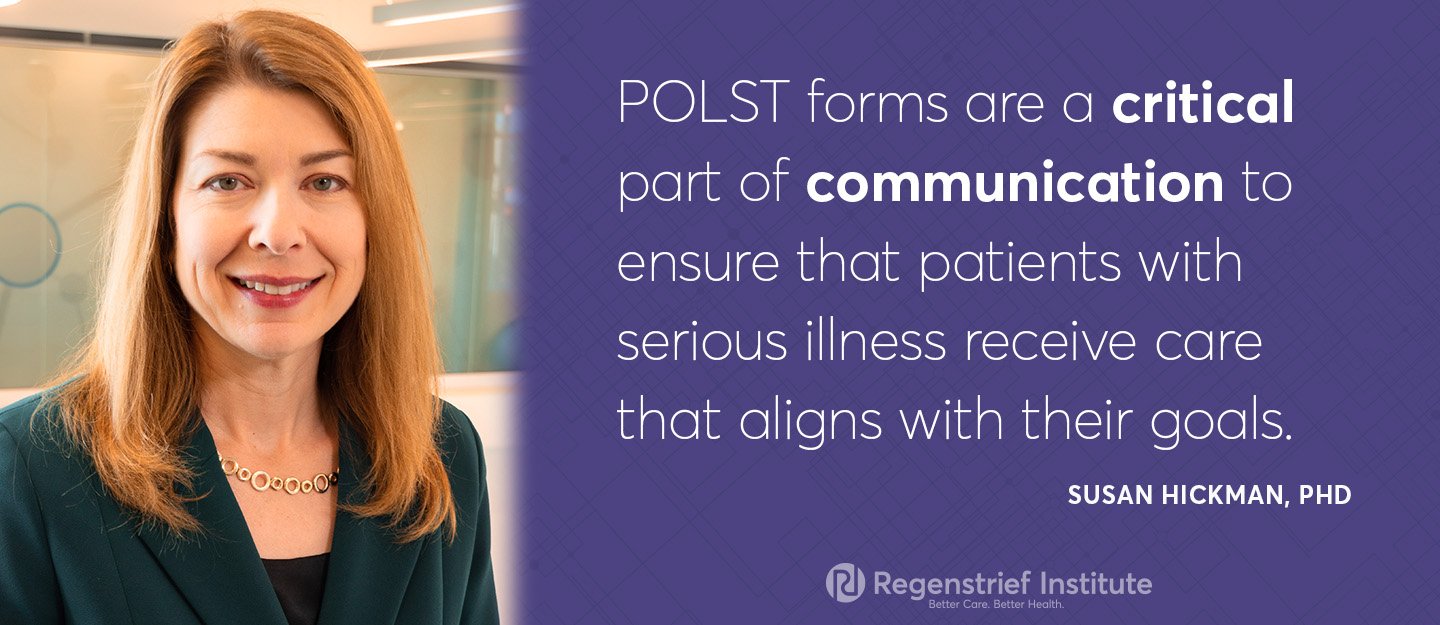Nursing home residents with medical order forms indicating their treatment preferences were three times more likely to have their current preferences documented in their medical record than residents without the forms, according to a study from Indiana University School of Nursing and IU Center for Aging Research at Regenstrief Institute.
POLST is a medical order form that documents what sort of life-sustaining treatments a person prefers to receive or not receive, such as hospitalization or comfort-focused care. POLST provides more specific directions than advance directives. The POLST form is used widely in nursing homes throughout the United States, though the name varies by state.
“POLST forms are a critical part of communication to ensure that patients with serious illness receive care that aligns with their goals,” said study first author Susan Hickman, PhD, director of the IU Center for Aging Research at Regenstrief and professor at IU School of Medicine and IU School of Nursing. “Often, preferences are not communicated with providers, which can lead to more aggressive care than what the patient wanted. This research shows that POLST forms are effective at communicating current care preferences and increases the likelihood that treatments will match preferences.”
The study team measured concordance between documentation and current preferences for nursing home residents in 40 Indiana facilities. The researchers compared residents in long-stay facilities who used POLST forms with residents in facilities that did not. They found that preference matched documentation 59 percent of the time for residents with a POLST and 35 percent for residents without.
“The difference in concordance shows that having a written record is useful and does lead to care better matching preferences, however, it also shows that there is still room for improvement in ensuring preferences are known,” said Dr. Hickman. “Advance care planning conversations can be difficult. We need to provide support to residents and families who are making these decisions and encourage revisiting decisions as circumstances change.”
“Do Life-sustaining Treatment Orders Match Patient and Surrogate Preferences? The Role of POLST” was published online in the Journal of General Internal Medicine ahead of print. This study was supported by the Retirement Research Foundation and the National Institute of Nursing Research of the National Institutes of Health under grant number R01NR015255.
Other authors on the paper are Alexia M. Torke, M.D., and Greg Sachs, M.D., IU Center for Aging Research at Regenstrief Institute and IU School of Medicine, Rebecca l. Sudore, M.D., University of California San Francisco School of Medicine; Qing Tang, M.S., and Giorgos Bakoyannis, PhD, IU School of Medicine and Indiana University Richard M. Fairbanks School of Public Health at IUPUI; Nicholette Heim Smith, BSN, and Anne L. Myers, MPH, IU School of Nursing; and Bernard J. Hammes, PhD, Respecting Choices, a division of C-TAC Innovations.
About Regenstrief Institute
Founded in 1969 in Indianapolis, the Regenstrief Institute is a local, national and global leader dedicated to a world where better information empowers people to end disease and realize true health. A key research partner to Indiana University, Regenstrief and its research scientists are responsible for a growing number of major healthcare innovations and studies. Examples range from the development of global health information technology standards that enable the use and interoperability of electronic health records to improving patient-physician communications, to creating models of care that inform practice and improve the lives of patients around the globe.
Sam Regenstrief, a nationally successful entrepreneur from Connersville, Indiana, founded the institute with the goal of making healthcare more efficient and accessible for everyone. His vision continues to guide the institute’s research mission.
About IU School of Nursing
Indiana University School of Nursing is one of the largest nursing schools in the nation that offers a full range of programs from undergraduate to doctoral. Almost 21,000 IUSON alumni across the globe are empowered to be leaders in clinical practice, research, education, and innovation. The School’s Master’s and DNP programs are both ranked #1 in Indiana according to U.S. News & World Report with the master’s program ranked in the top 50 in the United States.
About IU School of Medicine
IU School of Medicine is the largest medical school in the U.S. and is annually ranked among the top medical schools in the nation by U.S. News & World Report. The school offers high-quality medical education, access to leading medical research and rich campus life in nine Indiana cities, including rural and urban locations consistently recognized for livability.
About Susan Hickman, PhD
In addition to leading the IU Center for Aging Research at Regenstrief Institute, Susan Hickman, PhD, is a professor at Indiana University School of Nursing, a professor and Cornelius and Yvonne Pettinga Chair of Aging Research at IU School of Medicine, and the co-director of the IUPUI Research in Palliative and End-of-Life Communicating and Training (RESPECT) Signature Center.










